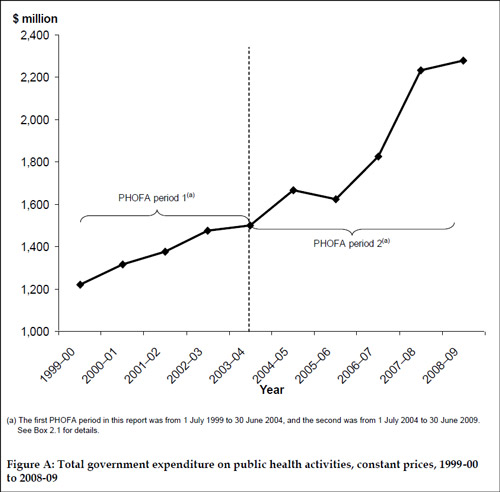Summary
Public health focuses on prevention, promotion and protection rather than on treatment, on populations rather than on individuals, and on the factors and behaviours that cause illness and injury.
Public health includes a wide variety of activities. However, the estimates included in the Public health expenditure in Australia series relate only to public health activities where the funding was provided by the key health departments and agencies in Australia.
Total expenditure continues to increase
Total expenditure on public health activities in Australia in 2008–09 was $2,300.2 million or $106 per person on average. This was an increase of $120.5 million, or 5.5%, on what was spent in 2007–08. After adjusting for the effects of inflation, there was a real increase in expenditure of 2.2% from 2007–08 to 2008–09, continuing the growth in public health expenditure which has averaged 7.3% per year since 1999–00.
Prior to 2007–08, the proportion of public health expenditure to total recurrent health expenditure was maintained at 1.8% to 1.9%. Since then the relatively large growth in public health expenditure has meant that public health expenditure as a proportion of total health expenditure increased to 2.2% in 2007–08 and was 2.1% in 2008–09.
Priorities continue to evolve
Public health activity is reported against eight core categories encompassing a range of preventative, health promotion and research activities.
Over the decade to 2008–09 there have been relative peaks in public health expenditure, often as a result of the varying implementation and ongoing cost profile of programs across years. As shown in Figure A, such peaks occurred in 2004–05 and 2007–08. The latter is attributed to expenditure on the National Human Papillomavirus vaccination program in that year.
The areas of public health expenditure that had the largest increases in real terms from 2007–08 to 2008–09 were the Selected health promotion (15.8%) and Screening programs (12.7%). The largest decrease in expenditure was for Organised immunisation activities (–12.0%), which was largely due to declining expenditure associated with the catch-up elements of the National Human Papillomavirus vaccination program. Despite the 2008–09 decline, Organised immunisation expenditure grew by an average of 13.7% per year between 1999–00 and 2008–09—the fastest growth rate of all the public health activities over that period.
Figure A: Total government expenditure on public health activities, constant prices, 1999-00 to 2008-09




